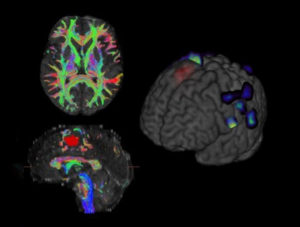Functional magnetic resonance imaging, or fMRI, is a technique for measuring brain activity.
It works by detecting the changes in blood oxygenation and flow that occur in response to neural activity – when a brain area is more active it consumes more oxygen and to meet this increased demand blood flow increases to the active area.
fMRI can be used to produce activation maps showing which parts of the brain are involved in a particular mental process.
What Does an fMRI Scan Look Like?

The image shown is the result of the simplest kind of fMRI Visual system experiment. While lying in the MRI scanner the subject watched a screen that alternated between showing a visual stimulus and being dark every 30 second. Meanwhile the MRI scanner tracked the signal throughout the brain. In brain areas responding to the visual stimulus you would expect the signal to go up and down as the stimulus is turned on and off, albeit blurred slightly by the delay in the blood flow response.
Advantages of FMRI Technology
As a brain imaging technique FMRI Monitor has several significant advantages:
- It can noninvasively record brain signals without risks of radiation inherent in other scanning methods, such as CT or PET scans.
- It can record signals from all regions of the brain, unlike EEG/MEG which are biased towards the cortical surface.
- It has a high spatial resolution. 2–3 mm is typical but resolution can be as good as 1mm.
- fMRI produces compelling images of brain “activation”.
- fMRI enables the detection of abnormalities of the brain, as well as the assessment of the normal functional anatomy of the brain, which cannot be accomplished with other imaging techniques.
- fMRI is widely used and standard data-analysis approaches have been developed which allow researchers to compare results across labs.
- The attractions of FMRI have made it a popular tool for imaging normal brain function – especially for psychologists.
Benefits of FMRI Technology to Doctors and Hospitals
- Physicians use fMRI to assess how risky brain surgery or similar invasive treatment is for a patient and to learn how a normal, diseased or injured brain is functioning. This is useful to plan for surgery and radiation therapy of the brain.
- Clinicians also use fMRI to anatomically map the brain and detect the effects of tumours, stroke, head and brain injury, or diseases such as Alzheimer’s, and developmental disabilities such as Autism etc.
- Mapping of functional areas and understanding lateralization of language and memory help surgeons avoid removing critical brain regions when they have to operate and remove brain tissue.
- Pharmacological fMRI, assaying brain activity after drugs are administered, can be used to check how much a drug penetrates the Blood–brain barrier and dose vs effect information of the medication.
- Over the last decade, it has provided new insight to the investigation of how memories are formed, language, pain, learning and emotion to name but a few areas of research. FMRI is also being applied in clinical and commercial settings.
- Functional Magnetic Resonance imaging plays an important roles in management and treatment of several diseases like epilepsy, Alzheimer’s disease, psychiatric disease.

